Bulova’s Archive Series revisits some of the historical brand’s most cult-classic pieces from the mid-20th century, from digital-era pioneers like the Computron LED to distinctive deep-sea divers like the Oceanographers. Recently, I had the opportunity for an extended session with one of the most colorful, playful, and defiantly retro of the lot, the Chronograph A “Surfboard,” which joined the vintage-inspired collection earlier this year.
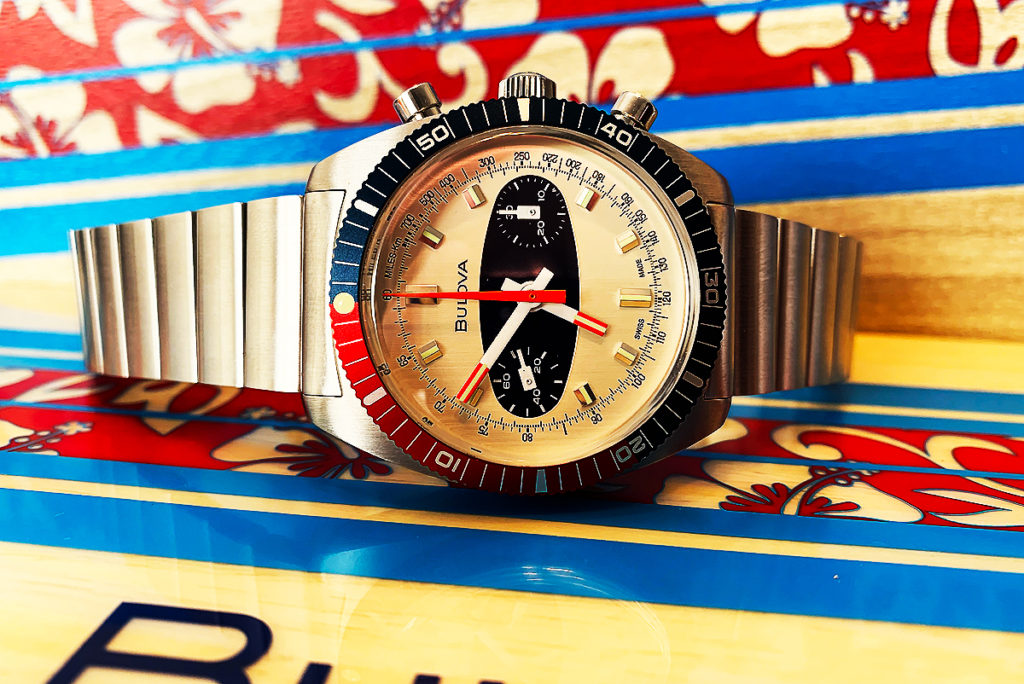
The original watch, nicknamed for the quirky, blue surfboard-shaped oval encompassing the two subdial counters at 3 and 9 o’clock, was produced for only two years, in 1970 and 1971. As we’ve all seen from the booming vintage-look market, however, a watch need not have been a smashing commercial success in its original incarnation to be fertile ground for a successful re-edition. And the retro charm of the Chronograph A Surfboard is undeniable, particularly the Limited Edition model that I had the opportunity to review, which is the only one of four total new models to be outfitted with a mechanical, automatic movement (the other three have quartz calibers, slightly larger case diameters, and a range of contemporary colorways).
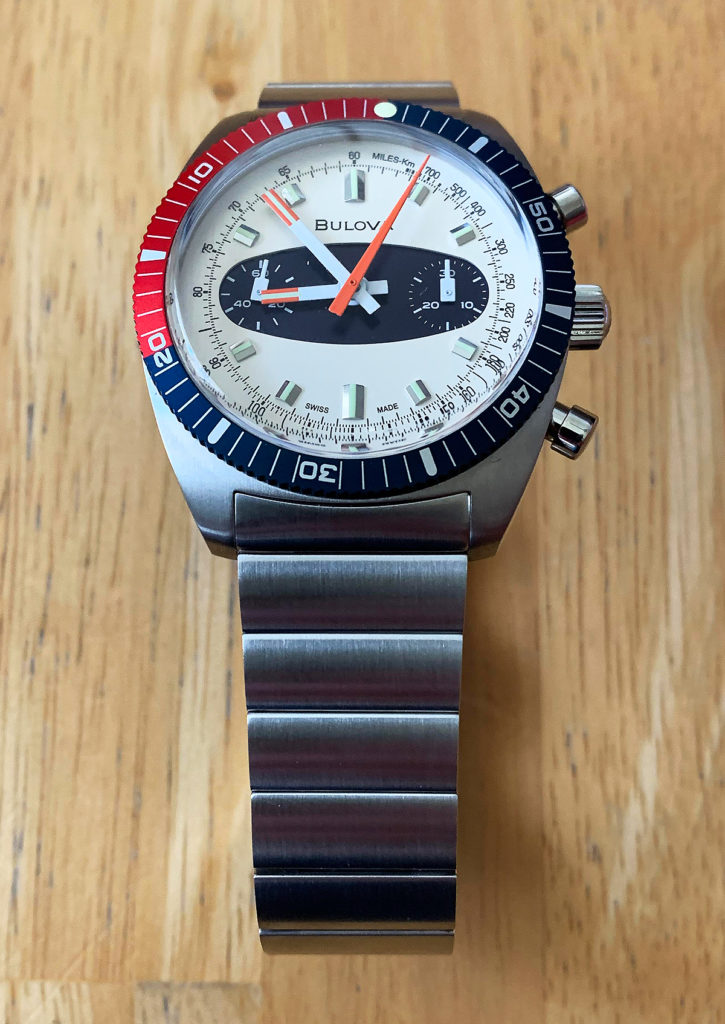
The 38-mm stainless steel case of the Chronograph A “Surfboard” is tonneau-shaped, though the prominent, colorful bezel makes it appear more rounded. It has a brushed finish on most of its surfaces, with the notable exception of the curving sides, which are polished. The watch has a somewhat chunky profile (16.7 mm thick) with the fluted bezel rising above the main curve of the case and a subtly domed sapphire crystal, with antireflective coating, reaching above that.
The crown and chronograph pushers also have a shiny polished finish on their surfaces. The crown is fluted and screws into the case. It’s also rather small for fingers to grasp, but not excessively so. The pushers are mushroom-shaped, as was common on sports watches from the era of its ancestor, and can be engaged with the soft but firm press of a forefinger. The top right pusher starts and stops the thin, pyramid-shaped central chronograph hand, while the lower right one sends it flying back to zero.
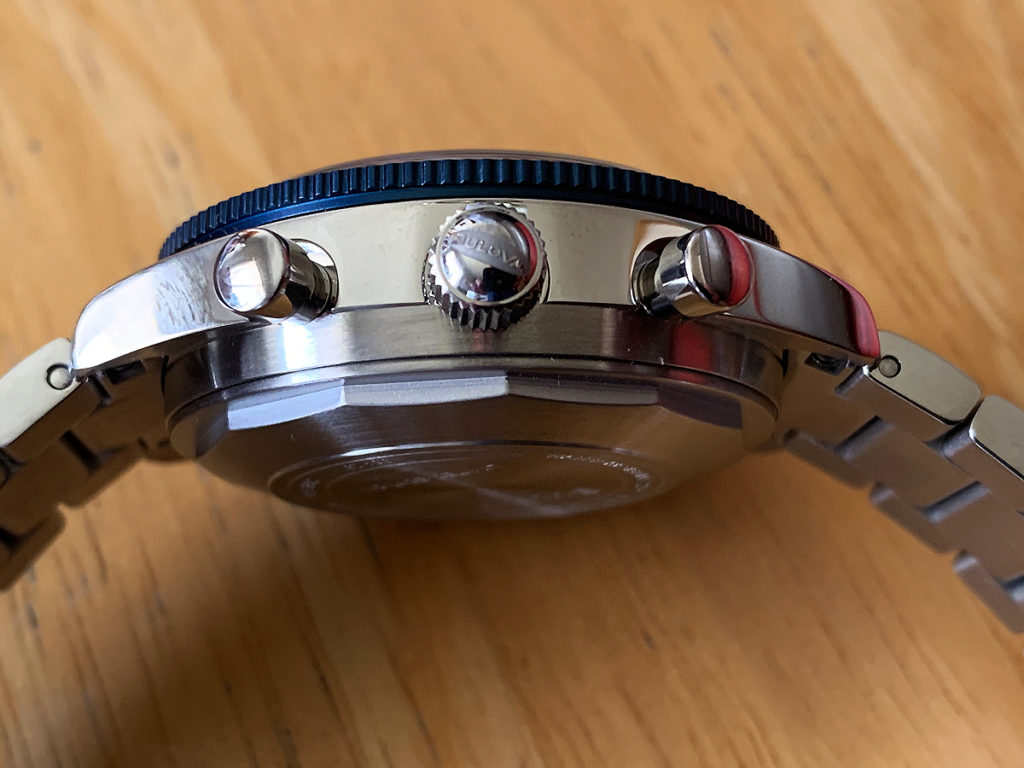
Distinguishing the cream-colored dial (Bulova describes it as beige) are a number of retro details derived directly from the 1970s original. To start with the outermost border of the dial, there’s a black-printed tachymeter scale — very small, as necessitated by the modest dimensions of the dial and case — which is a mainstay of many vintage chronographs that hail from that era. The applied indices are rectangular, with a stripe of Super-LumNova in their slightly raised center; the markers at 12 and 6 o’clock are slightly longer, and the ones for 3 and 9 o’clock are absent, as those positions are eclipsed by the ends of the dark blue “surfboard” and the two small, borderless subdials that occupy those positions.
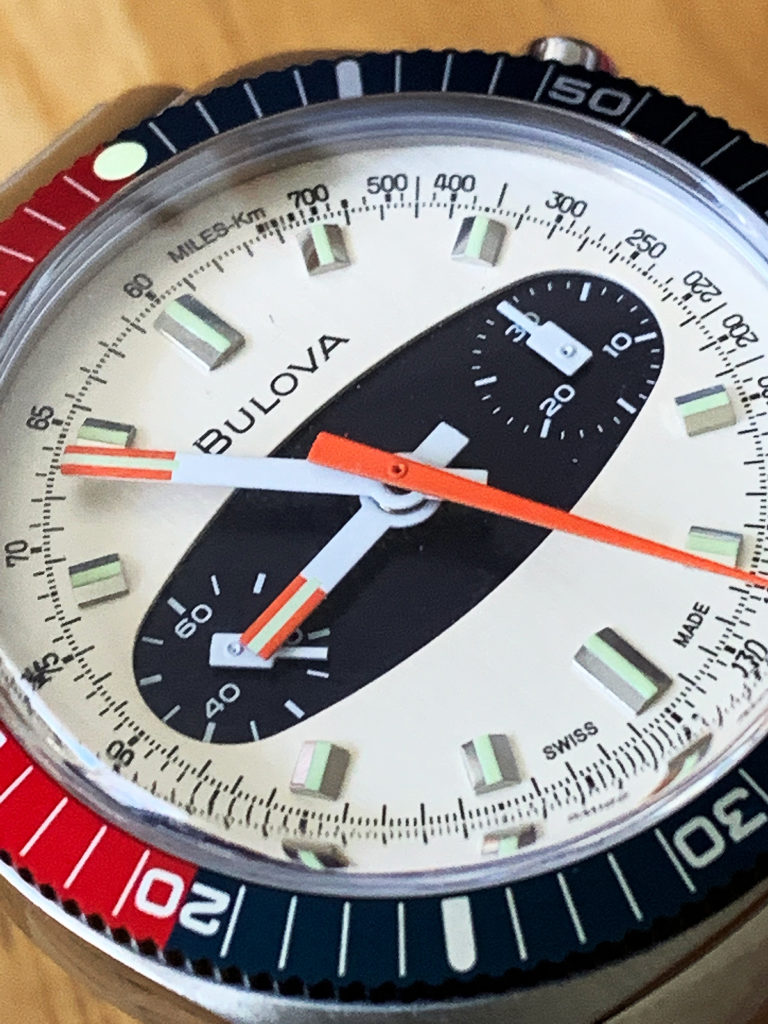
The hour and minute hand are thin white rectangles, with tips colored in the same orange as the aforementioned chronograph seconds hand and featuring the same luminous stripe as the hour markers. Hour and minute are easily distinguished at a glance thanks to their different sizes. The subdial at 9 o’clock displays running seconds, while the subdial at 3 o’clock tallies 30 elapsed minutes for the chronograph. Both use white numerals and indexes and unconventional-shaped white hands that could be described as bottle-shaped, or perhaps paddle-shaped. Again, the condensed size of the watch means that these readouts are not necessarily the most easily legible in the world, but vintage verisimilitude is more the intention here, and in that the design succeeds admirably. The combination of multicolored elements — orange hands over the off-white dial, odd-shaped, tiny white hands over the blue surfboard, framed by the red-white-and metallic bezel, and accented by bright green luminous details — makes for an eye-catching dial indeed.
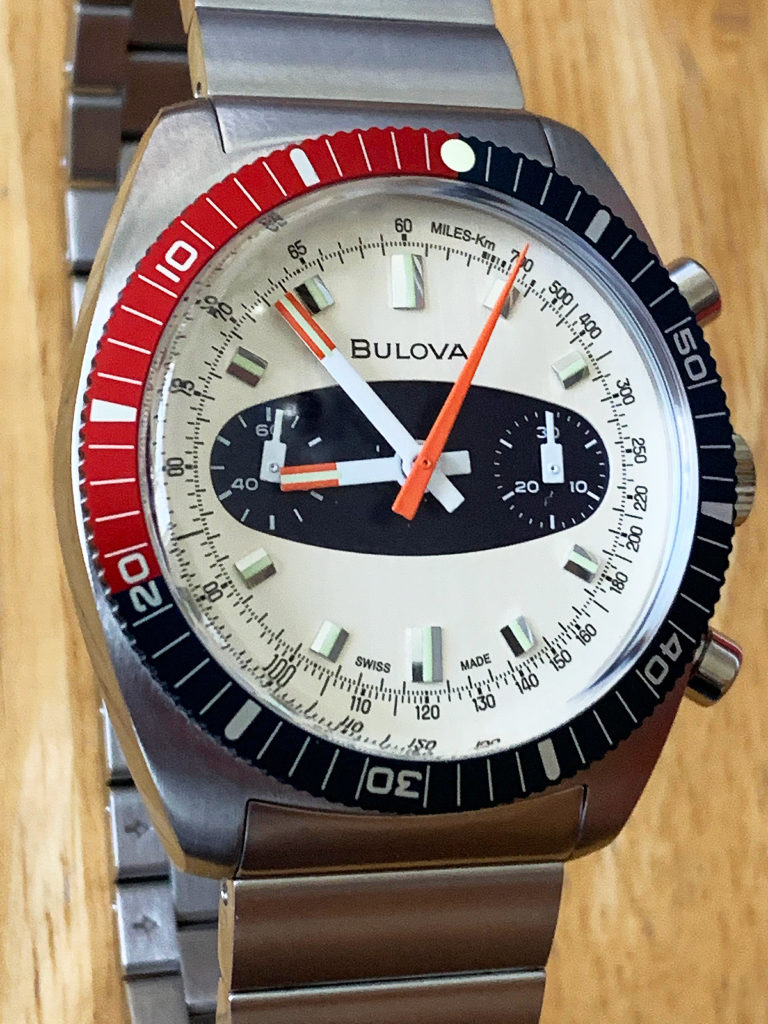
Behind a solid screwed caseback, which is relatively unadorned except for its sunburst finish, engraved Bulova logo and limited edition number, is the automatic Sellita Caliber SW510 BH b, based on the increasingly ubiquitous Sellita SW500-1, which was designed as an alternative to the even more ubiquitous ETA Valjoux 7750 chronograph caliber. The movement contains 27 jewels and hosts a power reserve of 48 hours when fully wound. The case is smoothly integrated into a very retro-looking steel bracelet whose wide, rectangular single links bear a brushed finish on their surfaces and a polished finish on their sides. The bracelet fastens to the wrist with a double-folding steel clasp that disengages with a firm button push to both sides.

Like many of its predecessors in Bulova’s Archive collection, the Chronograph A “Surfboard” makes a bold statement in just about any setting, and signals Bulova’s continuing commitment to mining its recent past for timepieces ready to step out of their historical comfort zone and impress an entirely new, contemporary audience. In the case of this watch, perhaps it can be described as waxing up an old surfboard to ride a brand-new wave.
| Manufacturer: | Bulova Corporation, Empire State Building, 350 Fifth Avenue, New York, NY 10118 |
| Reference number: | 98A251 |
| Functions: | Hours, minutes, small seconds, chronograph |
| Movement: | Sellita SW510, automatic, 27 jewels, 48-hour power reserve, 28,800-vph frequency, 30-mm diameter |
| Case: | Stainless-steel case with solid caseback, screw-in crown, domed sapphire crystal with antireflective coating, water resistant to 200 meters |
| Bracelet and clasp: | Stainless-steel bracelet with deployant clasp |
| Dimensions: | Diameter = 38.5 mm, height = 16.7 mm |
| Price: | $2,950 (limited edition of 250 pieces) |

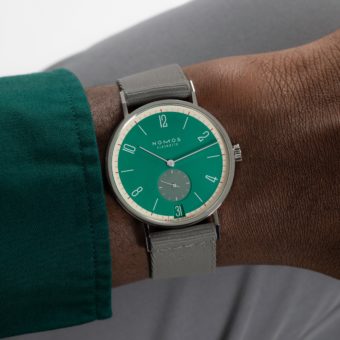
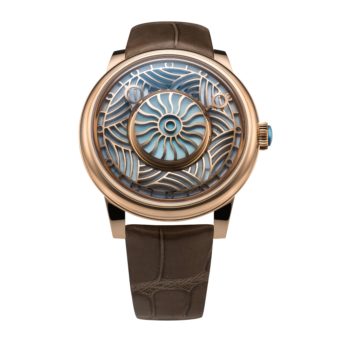
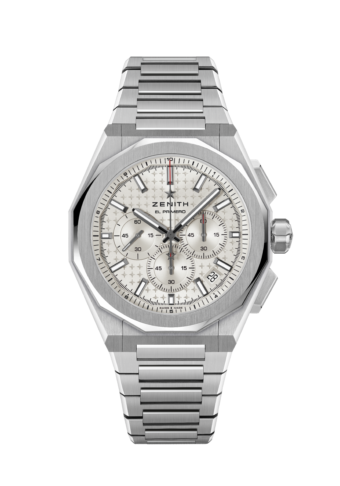
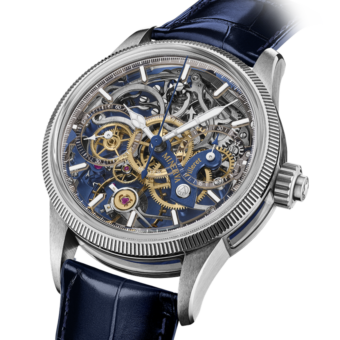
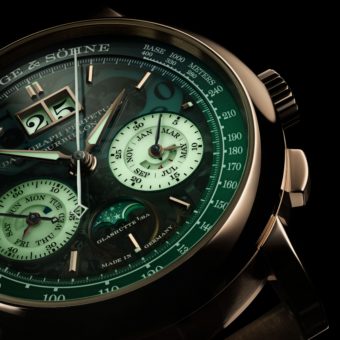
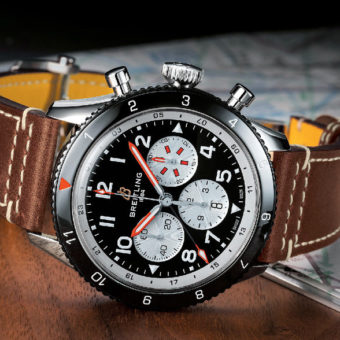
I like it and like the surfboard throwback, but I don’t $3000 like it. Maybe $1000 like it which would already make it double the price of the quartz Costco surfboard available. I’m willing to pay double for a less accurate ubiquitous automatic movement over as more accurate nameless quartz movement, but I’m not going to pay Tag Link prices for a Bulova with an off the shelf movement. I think they’re being a little too much on supply and demand when they could have made this a 5000 piece LE for $1000 and printed money with it. I would have bought the Costco surfboard the day I saw is but it was quartz, and this is not a watch I want in quartz now do I believe it’s worth to end Casio money for a lesser quartz movement
Great. The online Swiss made
Believe there is also a quartz version for well under $1,000